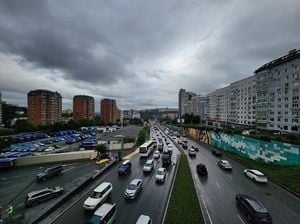In the quiet town of Tuam, Ireland, a grim chapter of history is finally being confronted as forensic teams begin exhuming the remains of nearly 800 infants and young children from the grounds of a former mother and baby home. This mass grave, some of it found within a defunct septic tank, has forced Ireland and its deeply intertwined Catholic Church to reckon with decades of cruelty and silence surrounding the treatment of unmarried mothers and their children.
The story begins in the 1970s when two boys, Franny Hopkins and Barry Sweeney, were chased from an orchard and escaped over the stone wall of the derelict Bon Secours Mother and Baby Home. There, beneath brambles and a concrete slab, they stumbled upon a jumble of bones. At the time, the full horror of what they had found was not understood. It would take decades for the truth to surface, largely due to the dedication of local historian Catherine Corless.
Corless, a homemaker with a passion for local history, began investigating the abandoned home in the early 2010s. What started as a modest article for the Journal of the Old Tuam Society in 2012 soon revealed a staggering reality: 796 recorded deaths of children at the home with no burial records. The bones discovered by the boys were in fact buried in a disused septic tank on the site, a shocking detail that ignited a national and international outcry when journalist Alison O’Reilly published a front-page story in the Irish Mail in 2014 titled “A Mass Grave of 800 Babies.”
The Tuam mother and baby home operated from 1925 to 1961 in a repurposed 19th-century workhouse originally built in the 1840s to house the destitute. Run by the Bon Secours Sisters, a Catholic order of nuns, the home was primitive and overcrowded. There was no running water beyond the kitchen and maternity ward, no heating in the dormitories, and large dormitories housed more than 200 children and 100 mothers at a time.
Women who became pregnant outside marriage were often sent to these homes in secret, shamed by their families and communities. Many were essentially incarcerated, forced to work without pay for up to a year before being sent away, often never to see their children again. The men responsible for these pregnancies—whether through consensual relationships, rape, or incest—rarely faced any consequences.
The conditions inside the home were harsh and deadly. Infant mortality rates were horrific, with some years seeing over 40% of babies die before their first birthday. At Tuam, nearly a third of all children born there perished. A 1947 inspection report described infants as “delicate,” “wasted,” and “emaciated,” with one child, John Dolan, born healthy but later described as a “miserable, emaciated child” who died during a measles outbreak. Another, William Dolan, was listed as dying in 1951, but no death certificate exists, and his birth date was altered, a common tactic used to disguise illegal adoptions.
Stories like that of Anna Corrigan, who discovered her mother had given birth to two sons at the Tuam home—both of whom died—bring a deeply personal dimension to this tragedy. Corrigan said, “I cried for brothers I didn’t know, because now I had siblings, but I never knew them.”
Similarly, Annette McKay’s mother, Margaret “Maggie” O’Connor, was sent to the home after being raped as a teenager. Six months after giving birth, a nun told her, “the child of your sin is dead,” a secret she carried silently for decades. McKay later found her long-lost sister’s name among the records of children who died at Tuam.
Barbara Buckley, born in the home in 1957 and adopted at 19 months, later met her birth mother who had worked in the laundry. Her mother’s lasting memory was the sky above the high walls, and she told Buckley she would never see her again, fearing the stigma of their connection would be exposed.
The discovery and subsequent revelations have prompted a national reckoning. In 2014, then-Prime Minister Enda Kenny called the site a “chamber of horrors” after test excavations confirmed the presence of children’s skeletons in the septic tank. Pope Francis publicly apologized during his 2018 visit to Ireland for the church’s role in systemic abuse, including the forced separation of unwed mothers and their children.
In 2021, the Commission of Investigation into Mother and Baby Homes reported that approximately 9,000 children, or 15%, died in 18 such institutions across Ireland from 1922 to 1998, with Tuam having the highest death rate. Prime Minister Micheál Martin issued a formal apology, saying, “The shame was not theirs—it was ours.” The Bon Secours Sisters also apologized, with Sister Eileen O’Connor stating, “We failed to respect the inherent dignity of the women and children. We failed to offer them the compassion that they so badly needed.”
Following legislation passed in 2022, the Institutional Burials Act authorized the excavation, recovery, and identification of remains. In 2023, the Director of Authorised Intervention was appointed to oversee the Tuam excavation, and on June 11, 2025, the site was secured, with pre-excavation work starting shortly thereafter. The excavation officially began on July 14, 2025.
A team led by Daniel MacSweeney, a forensic expert formerly with the International Committee of the Red Cross, is conducting the delicate and complex work. “We cannot underestimate the complexity of the task before us,” MacSweeney said, citing the age of the remains, overlapping bones, and scarce historical records. The process of collecting, sorting, and identifying the remains using DNA is expected to take at least two years.
Nearly 100 people from countries including the UK, US, Canada, and Australia have submitted or are preparing to submit DNA samples, hoping to learn the fate of lost relatives. However, some locals believe the site should be left undisturbed, viewing it as a graveyard blessed by priests and memorialized with Masses over the years.
A week before the excavation began, survivors and relatives of the mothers who toiled there gathered for a final visit to the site. The area, once a playground and garden, was now surrounded by shipping containers, dumpsters, and excavation equipment. Anna Corrigan reflected on the long wait for justice: “They were denied dignity in life, and they were denied dignity and respect in death. So we’re hoping that today maybe will be the start of hearing them because I think they’ve been crying for an awful long time to be heard.”
As Ireland confronts this painful legacy, the excavation at Tuam serves as a somber reminder of the human cost of institutional cruelty and societal shame. The work underway aims not only to uncover remains but to restore dignity and provide answers to families long haunted by loss and silence.






